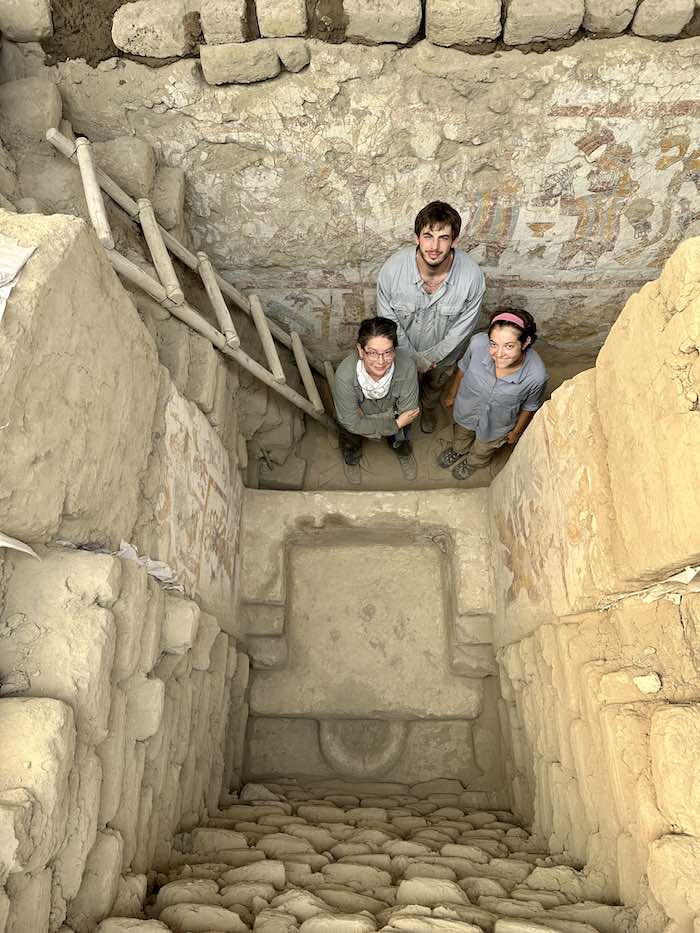
Excavations on a pre-Inca site in northern Peru revealed the presence of a throne room where court was held by a woman.
Unfairly obscured by the glory of the Incan Empire, the medieval Moche Culture are known as prolific builders and inspired artists, but it was during this season’s excavations that a startling revelation was made.

Among the remains of the archaeological site known as Pañamarca, a throne room richly decorated with murals has been dug up. The murals are nothing new, because at Pañamarca, there’s not one surface that’s bare, to quote one archaeologist on the dig team.
But this time the murals threw up a surprise—images of a queen, a high priestess, or female god, dominated the depictions. Sometimes receiving lines of people, sometimes sitting on a throne, and other times wielding a scepter—signs of a sovereign almost everywhere, the queen of Pañamarca has breathed new life into the study of this antique culture.
In the shadows of the Aztecs, Inca, and Maya, many other great cultures, civilizations, and even empires flourished in the Americas before the arrival of Europeans. The Moche Culture, with a heartland that rested around modern-day Trujillo in coastal northwest Peru, is just one of these peoples.
Existing from about 350 CE to 850 CE, the Moche painted every square inch of surface area on their large adobe temples and palaces with intricate murals. The most famous finds associated with the Moche are the Temples of the Sun and Moon a short drive from Trujillo.
In contrast to this important site and tourist attraction, Pañamarca is still under excavation, and is under the responsibility of the Archaeological Landscapes of Pañamarca, who released a statement on the discovery.
The adobe throne was found within what project director Jessica Ortiz Zevallos has named the “Hall of the Moche Imaginary” (Sala del Imaginario Moche). It is surrounded by walls and pillars depicting four different scenes of a powerful woman.
SOUTH AMERICAN ARCHAEOLOGY:
- Mystery of Nazca Lines Deepens as AI Survey Doubles Number of Geoglyphs and Alters Their Meaning
- Ancient Temple and Theater 3,500 years Older Than Machu Picchu Discovered in Peru
- Heaps of Gold Uncovered in 1,200-year-old Pre-Colombian Tomb in Panama
- Circular Stone Plaza Moves Up Start of Stone Age Construction in the Andes on Par with Stonehenge
- Jade Funerary Mask of Great Mayan King Found at Little-Known Site in Guatemala
Prior seasons of the project’s research documented a bevy of painted surfaces within this hall, including paintings of elegantly dressed men and women, human-animal hybrid warriors with spider, deer, canid, and serpent features, and multiple battles between the Moche mythic hero and his enemies from the sea.

The powerful woman painted on the walls and pillars of the throne room—as well as on the interior surfaces of the throne itself—is associated with the crescent moon, with the sea and its creatures, and with the arts of spinning and weaving.
Mural paintings uncovered in July include a rare scene of an entire workshop of women spinning and weaving, as well as a procession of men carrying textiles and the female leader’s crown, complete with her braids.
Scholars will debate whether the woman painted on the walls of the throne room is human or mythical (a priestess, goddess, or queen). But the physical evidence of the throne, including the erosion to its back support and the recovery of greenstone beads, fine threads, and even human hair, make clear that it was occupied by a real living person—and the evidence all points to a seventh-century woman leader of Pañamarca.
“Pañamarca continues to surprise us,” says Lisa Trever, an art historian at Columbia University, in the statement, “not only for the ceaseless creativity of its painters but also because their works are overturning our expectations of gender roles in the ancient Moche world.”

The project’s excavations on Pañamarca’s plaza have also revealed a monumental structure that was entirely unknown to prior research. The Hall of the Braided Serpents (Sala de las Serpientes Trenzadas) was also built with wide square pillars. Many of these pillars were arrayed with paintings of intertwining serpents with human legs—a motif not seen elsewhere in Moche art.
Other surfaces were decorated with images of warriors, anthropomorphized weapons, and a large monster chasing a man. The Hall of the Braided Serpents underwent multiple renewal events that included copious material offerings—most notably textiles—burning events, the careful capping of floors, and the whitewashing of previously decorated walls.
“Perched above the plaza, this hall offered a prominent position—almost like box seats at a theater or stadium—from which to observe the goings-on down below, while it also provided private spaces for its privileged occupants,” explains archaeologist Michele L. Koons of the Denver Museum of Nature & Science.
SHARE This Incredible Discovery With Your Friends Who Love Archaeology…




















